|
Daniel Boone cabin at Netherland Inn in Kingsport
by W. Dale Carter, copyright 2009
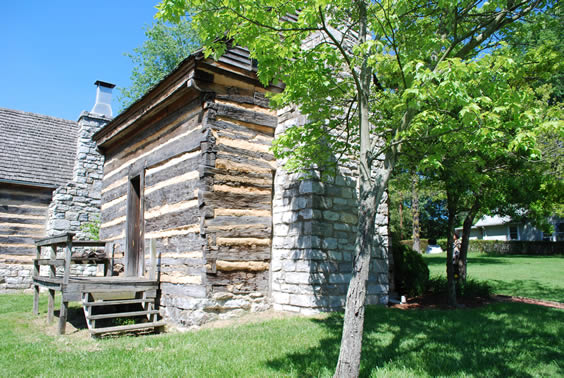
Log cabin on grounds of Netherland Inn complex
The purpose of this article is to set the record straight about the history of the so-called "Boone Cabin" located on the grounds of the Netherland Inn complex. A sign is located beside the cabin with the follow inscription:
1773
Boone Cabin
Children’s Museum
“In 1979/80 this 1773 cabin was carefully dismantled and moved from beside the Kentucky Wilderness Road in Duffield, Virginia and reassembled here on the foundation of the Netherland Inn Slave Cabin home of a beloved, Jordan Netherland & his wife Jane Lynn. This was the 1773-75 home of Daniel & Rebecca Boone and later the Ephriam Fraley home. It is a fine specimen of the typical early pioneer log architecture of the region”.

Interpretative marker at Netherland Inn (see inset left for "1773 Boone Cabin")
While there is some notion that Daniel Boone and his family lived in a log cabin in Duffield, Virginia from the Fall of 1773 until the early Summer of 1775, the idea is without merit and is based on local folklore and is not supported by any known documentation. Factual documentation clearly shows that Boone set out with a party of five families from his home in North Carolina on his way to Kentucky. He traveled as far as the mouth of Wallins creek in present day Lee County, Virginia, but he was forced to abort the journey when the Indians attacked a part of the expedition that was traveling about three miles to the rear of the main party. His son James was killed. The Boone expedition party decided it was too dangerous to continue the journey to Kentucky and some of the members of the Boone expedition returned to their homes in Carolina. Boone decided to take his family to the safety of Moore’s fort located in Castlewood, Russell County, Virginia. His family resided there from October 1773 until June of 1775.
The Draper manuscripts located in the Wisconsin Historical Society collections at Madison Wisconsin has the following document:
“An amusing story is told of the Boone family while they were living in Moore's Fort by Mrs. Samuel Scott of Jessamine County, Kentucky, who was also at the time living in the fort. Mrs. Scott says the men had become very careless in guarding the fort, lounging outside the gates, playing ball and in general lax in their duties. One day Mrs. Boone, her daughter, Mrs. Hannah Carr and some of the other ladies loaded their guns lightly, went out from the fort, shut the gates and shot their guns off in rapid succession like the Indians. The men all scrambled for the fort, but finding the gates shut none could get in, but one young man who managed to climb over the stockade wall. So great was their consternation that some of the men ran right through the pond in front of the fort. After they were finally let in the gates Mrs. Scott says the men were so mad some of them wanted to have the women whipped.”
Per Emory Hamilton based on the Draper MMS 11 CC 224, this document proves the Boone family was living in Castlewood at Moore’s Fort, Russell County, Virginia, not Duffield in Scott County.
The first owners of the area known today as Duffield were James Parberry, John Preston Jr., and John Balfour. Each obtained a land grant from the Commonwealth of Virginia. John Balfour sold his land grant to John McKinney on 16 Feb 1802 recorded in Lee County Deed Book 1, page 212. When McKinney attempted to establish the bounds of his newly acquired land, he found about 100 acres of his purchase lay within the boundary of the Preston grant and a lawsuit was filed in Augusta County to resolve the conflict of the property surveys. (1)
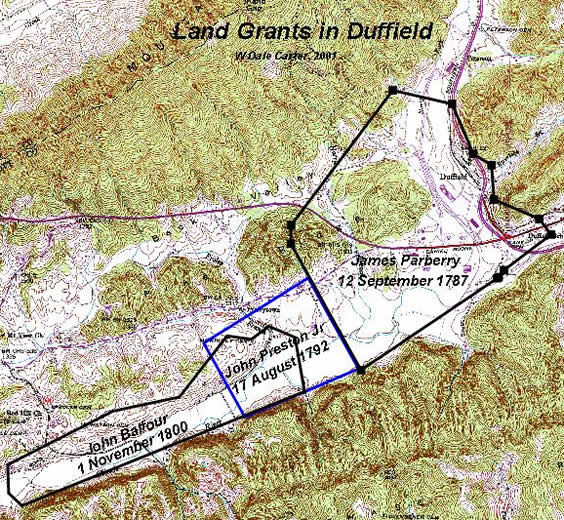
First landowners in the area of Duffield, Virginia
Due to the great distance of travel from Scott County to Augusta County depositions were taken of local residents and submitted to the court as evidence, and these depositions were recorded in the Augusta County court records. These depositions shed light on the early settlement around Duffield. The depositions show there was no permanent settlement made in the Duffield area before 1775. The Hoosers, Felty and his son John and Abraham built cabins on the North Fork of Clinch River in the Flat Lick around 1777. They were driven from their settlement by the Indians and the area “remained unsettled and dangerous until after 1785 because of the Indians”. It is illogical to suggest that Daniel Boone settled his family in the flat lick area in the fall of 1773.
In 1773, not a single family resided in the area around Duffield. The nearest settlement was at Fort Blackmore several miles to the east and on the Clinch River. Several families attempted to settle in Powell Valley in 1774, but they were driven from their homes with the onset of “Dunsmore’s War” and retreated to the safety of Fort Blackmore and Moore’s fort.
I have researched log home construction for near forty years with the objective of estimating the date of construction of a log building by observing the type of notch used to connect the logs at the corners of the building. Three types of notches were used in this section of the country, namely saddle notch, V notch, and half dove-tail notch.
- The very earliest cabins were constructed using round logs and saddle notches. The construction was simple and most anyone with an axe could erect a cabin in a few days. The cabins had no windows and no floor except the raw earth and the roof was constructed of bark or split shingles supported on poles and held in place with weight poles.
- A more permanent cabin would have been constructed of small logs 8 to 10 inches in diameter and hewn on two sides to a log thickness of 6 inches, and the logs were connected at the corners by a V notch. The V notch is a simple notch that an unskilled craftsman could make using only an axe as a tool.
- The half dove-tail notch is a far superior notch for connecting logs, but it is a complicated notch to fabricate requiring a craftsman with some specials skills that the average person does not possess. To date, I have not identified a single log house in southwest Virginia or northeast Tennessee built before about 1840 that used the half dove-tail notch. The so-called Boone Cabin at the Netherland Inn is constructed with the half dove-tail notch and the craftsmanship of the notches is not of high quality.
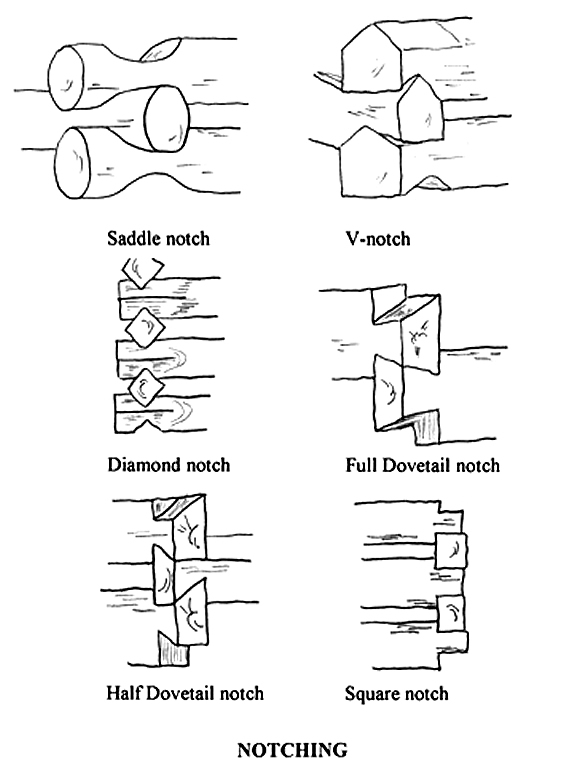
Conclusions:
The cabin located at the Netherland Inn is constructed using half-dovetail notches. Half-dove tail notches were not used to build log houses in the area before about 1840. Therefore I conclude the so-called Boone cabin was built after 1840 and more likely after the Civil War.
A careful analysis of the construction details and architectural features lead me to believe that the cabin is a hybrid... That is, it contains logs from two or more log buildings. The workmanship is poor. On the south end of the cabin, some of the logs are heavily weathered and other logs are weathered very little. The slope of the half-dovetail notches varies from no slope at all to a slope of 20-30 degrees. The next to the top log on the southwest corner of the building is approximately 4 inches off the center line of the building corner.

Southwest corner of cabin at Netherland Inn
The most unique feature of the building is the construction of the top log on the west side. The log rests on a projection of the log below it. The log it rests on is a short log that butts against another log. This feature is structurally unsound. The top log is hewn on four sides to a dimension of approximately 6 inches by 12 inches and forms the eaves of the house. The rafters rest on this log. I have never before seen this feature in a log house. It is obvious the design of the eave was not incorporated into the design of the original building. The logs on both ends of the cabin that support the eave log contain butt joints, which means they were not a part of the original cabin.
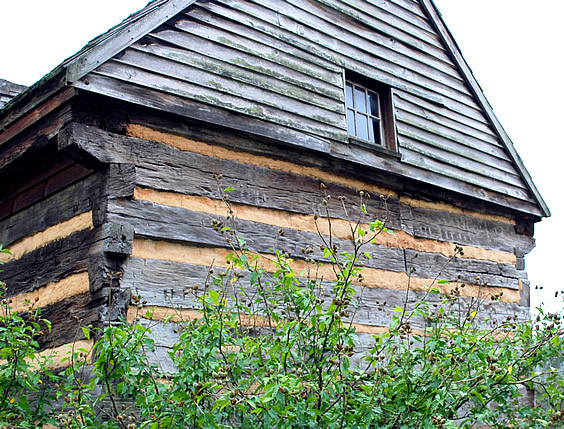
North end of cabin at Netherland Inn
The north end of the cabin is a patch-work of logs that have been pieced together to form the north end of the cabin. Six of the logs contain butt joints. The next to the top log northwest corner joint is out of alignment by at least four inches. It is clear the builders of the cabin used logs from two or more log buildings to construct the north end of the building.
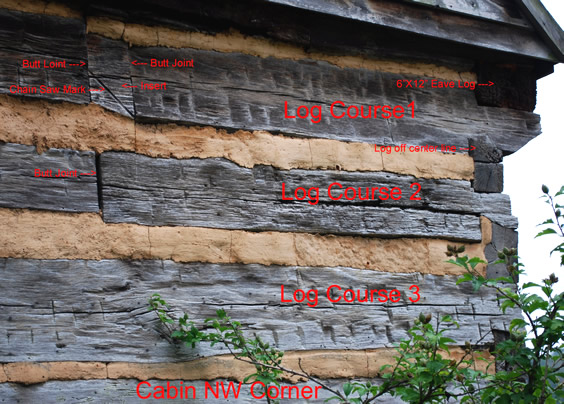
Northwest corner of cabin at Netherland Inn
The sign at the cabin states the “cabin was carefully dismantled and moved from beside the Kentucky Wilderness Road and reassembled”. This statement leads one to believe the cabin at the Netherland Inn end looks exactly as it did before it was moved to its present site. In my opinion, this statement is not true. The so-called Boone cabin was built with logs from dismantled log buildings. Apparently the workers that erected the cabin at the Netherland Inn complex were not able to find logs that would span the distance between the corners and had to resort to using two logs butt-jointed together to make the span between corners.
This cabin is not “a fine specimen of the typical early log home architecture of the region.” Half-dovetail notches were not used in the construction of the early log homes of the area. The unique design of the eaves of the cabin is one of a kind. No other log cabin in the area was constructed with this design. At least seven butt joint logs were used in the construction. No early log home would have used a butt joint. Trees were plentiful, if a log was not long enough to span the distance between the corners a new log would have been cut and notched to fit.
Finally, the log cabin construction is poorly crafted and no way can it be an original log cabin. Boone never lived in the cabin, the cabin was not built in 1773 and Boone never lived at Duffield. The sign next to the cabin needs to be corrected. The public and school children should not be misinformed and lead to believe that they have seen the cabin that the legendary Daniel Boone once lived in. What a travesty!
The true site of the cabin where Daniel Boone was supposed to have lived is located in Russell County, Virginia on the David Gist land claim near Moore’s Fort in Castlewood.
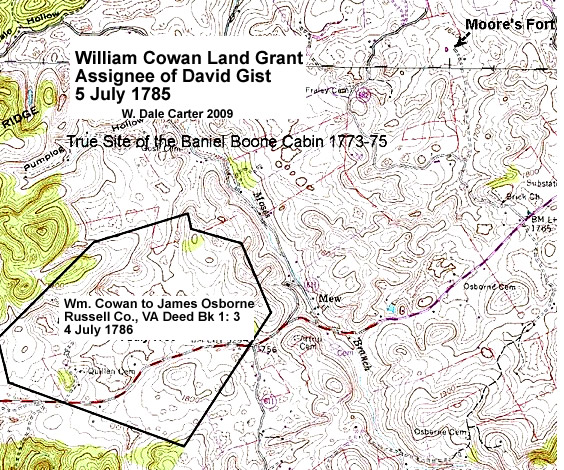
Actual site where Daniel Boone lived on Gist land near Moore's Fort in Castlewood, Russell Co., VA
References:
- Lyman Chalkley, Chronicles of the Scotch-Irish in Virginia Vol II, page 227.
- James Parberry land grant, Land Office grant Book 14, page 562.
- John Preston land grant, Land Office grant book 27, page 54.
- John Balfour land grant, Land Office grant book 46, page 398.
- Ephriam Fraley deed, Scott County Deed Book 41, page 361, 2 February 1899.
|
